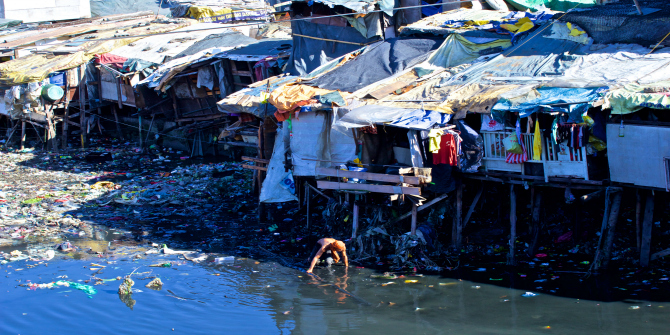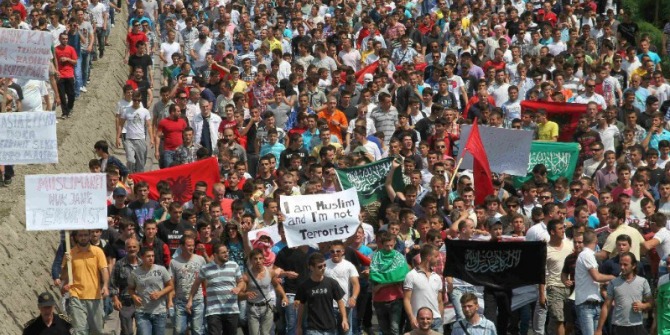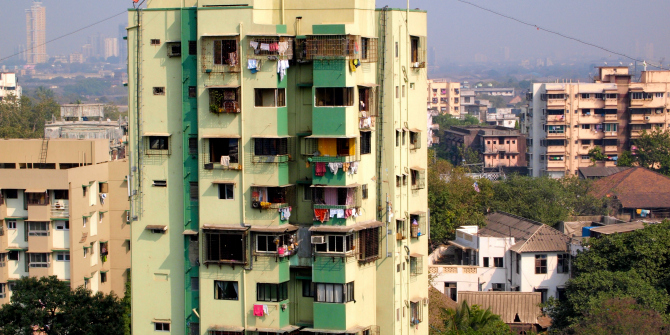In Global Poverty: Deprivation, Distribution and Development since the Cold War, Andy Sumner examines the persistence of poverty worldwide despite substantial economic growth, focusing particularly on its occurrence within Middle Income Countries (MICs). While the level of economic analysis may be less accessible to casual readers, this book offers a wealth of data for those considering how to ensure economic policymaking leads to more inclusive development, writes Hansley A. Juliano.
Global Poverty: Deprivation, Distribution and Development since the Cold War. Andy Sumner. Oxford University Press. 2016.
 According to the most recent Poverty Overview on the World Bank’s official website, ‘despite the progress made in reducing poverty, the number of people living in extreme poverty globally remains unacceptably high. And given global growth forecasts poverty reduction may not be fast enough to reach the target of ending extreme poverty by 2030.’ It has been argued both by news items and academic analyses that crippling global inequality and the failure of the global neoliberal economic platform have contributed to the resurgence of populist groups and right-wing political parties since the tailend of the 2008 global financial crisis. Golden Dawn in Greece, Front National in France, the triumph of the ‘Leave’ campaign in the United Kingdom as well as the gung-ho presidencies of Rodrigo Duterte in the Philippines and Donald J. Trump in the United States—these are only a handful of examples. It is probably appropriate then, in more ways than one, that Andy Sumner’s Global Poverty: Deprivation, Distribution and Development since the Cold War, dealing with the question of how poverty is experienced and systemically persisting worldwide, was published in the year 2016—the year we learned the hard lesson of how institutional blindness regarding systemic inequality can swing the masses away from traditional democratic institutions.
According to the most recent Poverty Overview on the World Bank’s official website, ‘despite the progress made in reducing poverty, the number of people living in extreme poverty globally remains unacceptably high. And given global growth forecasts poverty reduction may not be fast enough to reach the target of ending extreme poverty by 2030.’ It has been argued both by news items and academic analyses that crippling global inequality and the failure of the global neoliberal economic platform have contributed to the resurgence of populist groups and right-wing political parties since the tailend of the 2008 global financial crisis. Golden Dawn in Greece, Front National in France, the triumph of the ‘Leave’ campaign in the United Kingdom as well as the gung-ho presidencies of Rodrigo Duterte in the Philippines and Donald J. Trump in the United States—these are only a handful of examples. It is probably appropriate then, in more ways than one, that Andy Sumner’s Global Poverty: Deprivation, Distribution and Development since the Cold War, dealing with the question of how poverty is experienced and systemically persisting worldwide, was published in the year 2016—the year we learned the hard lesson of how institutional blindness regarding systemic inequality can swing the masses away from traditional democratic institutions.
At a time when institutions and debates are held hostage by interest groups and politicians who blame almost everything, promise too much and deliver nothing but damage to institutions and democratic rights, it is imperative that fundamental questions of poverty and development be looked at with piercing eyes, cold hard facts and a serious grasp of peoples’ day-to-day concerns. In this regard, Sumner’s book is a worthy contribution to the long-standing to-and-fro within the discipline of economics about the three deceptively simple-looking questions printed on the dust-jacket of the work: 1) ‘Why are some people poor?’; 2) ‘Why does absolute poverty persist despite substantial economic growth?’; and 3) ‘What types of late economic development are associated with different poverty outcomes?’
Going beyond quantitative models, Sumner cites case studies of multiple Middle Income Countries (MICs) — including Angola, Bangladesh, Brazil, Ghana, Indonesia, Mexico, Nigeria, Pakistan, South Sudan, Sri Lanka, Vietnam and many more — with particular focus on the biggest ones such as China and India. His answer to the questions posed above, as novel and as cross-cutting as they are, may serve as the bane of any policy partisan/apologist who either believes in the absolute freedom of markets or the alleged evils of all forms of global trade and intra-country exchange.
 Image Credit: (John Christian Fjellestad CC BY 2.0)
Image Credit: (John Christian Fjellestad CC BY 2.0)
Sumner’s book—a condensation of more than a dozen papers he wrote and co-wrote exploring spatial and geographic dimensions of poverty—answers the aforementioned three questions through five major arguments: 1) that ‘relatively few developing countries have achieved economic growth with structural change since the end of the Cold War’; 2) that ‘global poverty is concentrated in those countries and a relatively small set of those new MICs’, suggesting that ‘spatial and social inequality are important issues’; 3) that ‘substantial economic growth has not reduced poverty as one might expect’ due to patterns of inequitable distribution of resources; 4) that ‘addressing absolute poverty is affordable for many MICs but given inequality levels and trends, growth is unlikely to eliminate poverty’, making redistributive social policy and inclusive growth an imperative; and 5) that development aid to MICs cannot be terminated willy-nilly just because of economic growth, if only because of the aforementioned larger structural questions (156).
Sumner builds upon the work of other scholars dealing with poverty and economic development such as Simon Kuznets, who initially asserted that the long-run pattern of inequality involved ‘the concentration of savings and its impact on capital incomes versus political decisions and taxation’ (84-85). He demonstrates how ‘the relatively weak responsiveness of poverty to growth in new MICs is less due to initial levels of inequality as one might expect, but rather rising inequality during economic development which has dampened poverty reduction and skewed the benefits of growth away from the poorest’ (89). That is to say, the wellspring of economic growth may be filling up, but there is no means for every family within developing countries to share in this because only an established minority of the population has access to the well—and nobody has thought of creating a pipeline system for everyone else.
Chapter Four’s discussion of the ‘poverty paradox’ should be of particular interest to policymakers, economic planners, interest groups and peoples’ organisations of all shapes and stripes, if only because it argues that we need to broaden the scope of the discussion when we try to engage and assist the kinds of people experiencing poverty. Explicitly invoking the now recognisable term ‘precariat’, Sumner points out that this group, who are just hovering above the poverty line, ‘form the basis of a second layer to the poverty paradox which can constrain countries’ future growth, poverty reduction, and political change’ (128). The limited opportunities for advancement afforded this precariat, as Sumner continues in Chapter Five, make them a whole different proposition from the traditionally described ‘middle class’, and cannot be relied on by most states as the usual target for stimulating consumption demand or even taxation (147). They are the kind of people who need the assistance of the state most through social services and redistribution—and are the likeliest constituency for systemic, socio-economic change, whoever may promise it.
Sumner’s commitment to the technical aspects of economic analysis can be quite a challenge to casual readers. Yet Global Poverty is a valuable treasure trove of data and well-established arguments for anybody who wishes to make a case for publicly accountable and consultative economic policymaking. In an age when data and numbers are thrown around to make a case for ill-planned policies and decisions, Sumner’s work is a breath of fresh air, if a hard pill to swallow. It is, however, ultimately one which all countries (and interest groups seeking global socio-economic equity) need to address the long-delayed promise of inclusive development.
Hansley A. Juliano graduated in 2013 with a Master of Arts in Political Science, major in Global Politics, from the Ateneo de Manila University, Philippines. He currently serves as a lecturer in the Department of Political Science in the same university. His fields of interest include Southeast Asian politics,as well as political and economic development, with particular focus on land use conflicts, ethnic minority discrimination and state-social movement dynamics. Read more by Hansley A. Juliano.
Note: This review gives the views of the author, and not the position of the LSE Review of Books blog, or of the London School of Economics.







